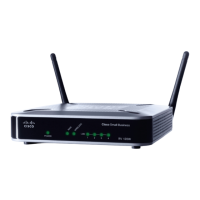Configuring Virtual Private Networks (VPNs) and Security
Configuring Security
Cisco RV 120W Administration Guide 115
5
Configuring VPN Passthrough
VPN passthrough allows VPN traffic that originates from VPN clients to pass
through the router. For example, if you are not using a VPN that is configured on the
Cisco RV 120W, but are using a laptop to access a VPN at another site, configuring
VPN passthrough allows that connection.
To configure VPN passthrough:
STEP 1 Choose VPN > VPN Passthrough.
STEP 2 Choose the type of traffic to allow to pass through the router:
• IPsec—Check Enable to allow IP security tunnels to pass through the router.
• PPTP—Check Enable to allow Point-to-Point Tunneling Protocol tunnels to
pass through the router.
• L2TP—Check Enable to allow Layer 2 Tunneling Protocol tunnels to pass
through the router.
STEP 3 Click Save.
Configuring Security
The Cisco RV 120W provides several security methods, including certificate
authentication, RADIUS server support, and 802.1x port-based authentication.
Using Certificates for Authentication
The Cisco RV 120W uses digital certificates for IPsec VPN authentication and SSL
validation (for HTTPS and SSL VPN authentication). You can obtain a digital
certificate from a well-known Certificate Authority (CA) such as VeriSign, or
generate and sign your own certificate using functionality available on this
gateway. The gateway comes with a self-signed certificate, and this can be
replaced by one signed by a CA as per your networking requirements. A CA
certificate provides strong assurance of the server's identity and is a requirement
for most corporate network VPN solutions.

